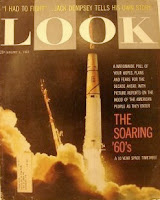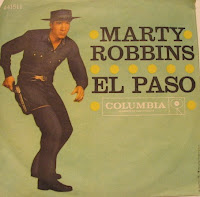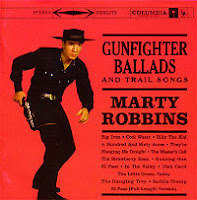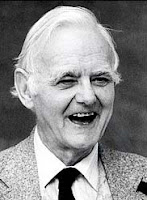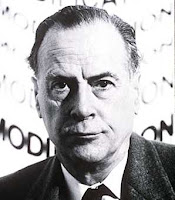 Media theorist Marshall McLuhan asserted that each new media takes as its content the older one. The movies, for instance, became the content of television. Now, the old television programs are (slowly) becoming the content of the internet (in the form of digital downloads). As an experiment trying to verify this theory, I tried to find out whether I could download any of the programs from Saturday night, January 2, 1960. (Saturday morning children's programming at the time, ironically, is something I don't remember well. I remember much better the evening programs, and in any case Saturday morning programming is not something I'd care to download, anyway, for reasons I'll have to explore in some future blog.) Our university library has several books which contain information about U. S. network programming of the past several decades, but since the university is currently on break and the library closed, I was unable to get hold of these books. I used Wikipedia instead, and indeed, found I could indeed recover the network television schedule for the 1959-1960 TV season. Next, I visited the Internet Movie Database in order to determine the specific episodes the networks broadcast that night.
Media theorist Marshall McLuhan asserted that each new media takes as its content the older one. The movies, for instance, became the content of television. Now, the old television programs are (slowly) becoming the content of the internet (in the form of digital downloads). As an experiment trying to verify this theory, I tried to find out whether I could download any of the programs from Saturday night, January 2, 1960. (Saturday morning children's programming at the time, ironically, is something I don't remember well. I remember much better the evening programs, and in any case Saturday morning programming is not something I'd care to download, anyway, for reasons I'll have to explore in some future blog.) Our university library has several books which contain information about U. S. network programming of the past several decades, but since the university is currently on break and the library closed, I was unable to get hold of these books. I used Wikipedia instead, and indeed, found I could indeed recover the network television schedule for the 1959-1960 TV season. Next, I visited the Internet Movie Database in order to determine the specific episodes the networks broadcast that night.
None of the programs televised that night are currently available in the form of downloads--but several of them are available, or will become available, on DVD. Of the ABC programs shown that evening, only Leave It to Beaver (8:30 p.m. EST) is available on DVD, and of the NBC programs, only Bonanza (7:30 p.m. EST) is available. CBS, however, has done a better job of making its programs available in digital format. The Perry Mason episode shown that night, "The Case of the Violent Village," is no doubt forthcoming on the Season Three DVD box set of that series, but Season Three hasn't been released yet. The Gunsmoke episode shown that night (the most popular show on television at the time), "Groat's Grudge," is not yet available on DVD (or download), either, although no doubt it will be. The Have Gun-Will Travel episode, "The Prophet," is available on DVD (but not download), but I was unable, alas, to get hold of the Season 3 box set. That left me with the one episode I did have, available on the Season Two box set of Wanted: Dead or Alive, "Mental Lapse." I also happened to have Season 1 of The Twilight Zone: The Definitive Edition, and therefore the episode that was televised 10:00 p.m. EST the night before, on January 1st, "The Four of Us Are Dying."
With these two half-hour programs in hand, I sat down and watched them back-to-back, "The Four of Us Are Dying" from January 1, and "Mental Lapse" from January 2, and--much to my surprise--learned that both starred Harry Townes (right), a marvelous actor I remember seeing on television for years.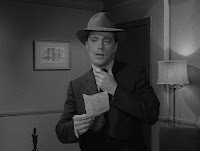 As far as I can remember I've always loved movies, but outside of Elvis Presley--the first "star" I can remember as a child--I grew up with greater familiarity with television actors than movie stars. Harry Townes is one of them--not that I could have given you his name at the time. Only years after, by virtue of reference books, could I have given you his name.
As far as I can remember I've always loved movies, but outside of Elvis Presley--the first "star" I can remember as a child--I grew up with greater familiarity with television actors than movie stars. Harry Townes is one of them--not that I could have given you his name at the time. Only years after, by virtue of reference books, could I have given you his name.
In "The Four of Us Are Dying," a sort of SF/noir hybrid, Harry Townes plays a hard-nosed con artist named Arch Hammer who has the ability to simulate the physical characteristics of others. By studying a snapshot of someone, he can "make his face change" and become that person, a replica of that person, complete with bodily mannerisms. As the episode begins, Hammer has arrived in New York City with some luggage filled with newspaper clippings containing pictures and news articles about a couple of men who recently suffered violent deaths. In the drama's first movement, he morphs into a dead musician named Johnny Foster in order meet--and to seduce--Foster's former, beautiful, girlfriend, a nightclub singer named Maggie (Beverly Garland). He becomes Johnny Foster and morphs into--Ross Martin! An experienced charmer, he convinces Maggie to quit her job after that night's show, with the promise that the two of them will run off together and have a great time (an offer, one infers, the real Johnny never made her). And why shouldn't I have a beautiful woman as a residual benefit? Hammer asks himself after leaving the club.
An experienced charmer, he convinces Maggie to quit her job after that night's show, with the promise that the two of them will run off together and have a great time (an offer, one infers, the real Johnny never made her). And why shouldn't I have a beautiful woman as a residual benefit? Hammer asks himself after leaving the club.
In the show's second movement, in order to acquire the much-needed cash for his upcoming fling with Maggie, Hammer morphs into the betrayed and murdered mobster Virgil Sterig, in order to extort money from his ex-boss, and becomes--Phillip Pine, 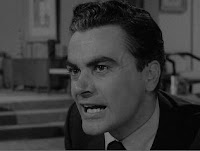 a fine veteran television actor I also well remember through television. However, before Sterig can successfully pull off his getaway after having extorted the money, two of his ex-boss's thugs arrive, and he's forced to run for his life. Trapped in an alleyway, with no clear escape in sight, in the nick of time he spots a tattered poster announcing a past boxing match, and at the last moment morphs into--a heel, Andy Marshak, played by Don Gordon.
a fine veteran television actor I also well remember through television. However, before Sterig can successfully pull off his getaway after having extorted the money, two of his ex-boss's thugs arrive, and he's forced to run for his life. Trapped in an alleyway, with no clear escape in sight, in the nick of time he spots a tattered poster announcing a past boxing match, and at the last moment morphs into--a heel, Andy Marshak, played by Don Gordon.  As was so characteristic of Rod Serling's rigid Puritan sensibility, Hammer's desperate, selfish act has unintended consequences: almost immediately, he unknowingly runs into Marshak's irate, pathological father who, at the show's conclusion, shoots and kills him because of what he (Marshak) has done to his mother and his girlfriend. In a sort of pre-Terminator 2 sequence that anticipates the T-1000's attempt to survive after falling into the molten ore, upon being shot Hammer tries to grab, hold on to, one of the simulacra he's become over the course of the evening--hence the inspiration for the show's title, "The Four of Us Are Dying." Such was the Twilight Zone on January 1, 1960.
As was so characteristic of Rod Serling's rigid Puritan sensibility, Hammer's desperate, selfish act has unintended consequences: almost immediately, he unknowingly runs into Marshak's irate, pathological father who, at the show's conclusion, shoots and kills him because of what he (Marshak) has done to his mother and his girlfriend. In a sort of pre-Terminator 2 sequence that anticipates the T-1000's attempt to survive after falling into the molten ore, upon being shot Hammer tries to grab, hold on to, one of the simulacra he's become over the course of the evening--hence the inspiration for the show's title, "The Four of Us Are Dying." Such was the Twilight Zone on January 1, 1960.
Serendipitously, I'd already planned to watch the January 2 Wanted: Dead or Alive episode, but near the end of the TZ episode's end credits, a brief segment urged viewers to look for Wanted: Dead or Alive (also a CBS show) on the same network. A minute or so later, as if heeding the suggestion made by the oracular announcer 48 years earlier, I had Wanted: Dead or Alive cued up--and there again, this time in a western setting, was Harry Townes. 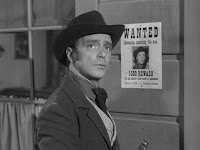 Interestingly, the episode was written by William F. Nolan, well-known as a SF/fantasy writer, perhaps best known for the feature film Logan's Run (1976). In the episode, Townes plays a man suffering from amnesia (hence the episode's title), who, at the story's opening, in a sort of Phlip K. Dickian twist, is improbably posting a "Wanted" poster asking for information about himself: who he is, what his name is, where he's from. Since he's offered a $500 reward for information about himself, bounty hunter Josh Randall (Steve McQueen) takes him up on his offer. It turns out that the character Townes plays is named Olin McDonald, falsely accused of killing his partner about a year earlier after the two had won a pot of money gambling. Subsequently attacked by the minions of the corrupt owner of the gambling hall, McDonald was left for dead, but later found on the trail--his memory gone (presumably by means of trauma to the head). By the show's end, he has experienced an anamnesis and the story ends happily, with McDonald reunited with his beloved.
Interestingly, the episode was written by William F. Nolan, well-known as a SF/fantasy writer, perhaps best known for the feature film Logan's Run (1976). In the episode, Townes plays a man suffering from amnesia (hence the episode's title), who, at the story's opening, in a sort of Phlip K. Dickian twist, is improbably posting a "Wanted" poster asking for information about himself: who he is, what his name is, where he's from. Since he's offered a $500 reward for information about himself, bounty hunter Josh Randall (Steve McQueen) takes him up on his offer. It turns out that the character Townes plays is named Olin McDonald, falsely accused of killing his partner about a year earlier after the two had won a pot of money gambling. Subsequently attacked by the minions of the corrupt owner of the gambling hall, McDonald was left for dead, but later found on the trail--his memory gone (presumably by means of trauma to the head). By the show's end, he has experienced an anamnesis and the story ends happily, with McDonald reunited with his beloved.
Although I'm not using the term precisely the way media theorists would like me to, the yield of information achieved by juxtaposing these two episodes is an example of the "convergence" achieved by the ease of digital sampling in the era of the internet (multiple sites available simultaneously), a presentation of information not available in the era of analogue broadcast. I had Wikipedia, the Imdb, and the episodes themselves in digital form. The sort of information yielded by the juxtaposition (convergence) of these various media would not have possible in the era the programs were originally broadcast. At present, the entire season of a particular show is available (or will be available); one wonders if, through internet downloads, whether (theoretically) an entire year of television is going to be (re) produceable.
Intrigued by the serendipity of seeing Harry Townes in the two episodes, I thought I'd learn the rest of the story. According his obituary in the New York Times, about a decade later Townes was ordained as an Episcopalian minister, an event, interestingly, anticipated in a Route 66 episode from 1960, The Strengthening Angels, in which he played a minister. 
A photograph, from years later, reveals Harry Townes in a different role, courtesy findagrave.com.
 Translation: the U.S. government convinced the American public that the Soviets’ ability to launch satellites meant they had the technology to launch ballistic missiles, that is, long-range rockets with nuclear bombs. A threshold moment, a new relationship between the government (military) and educational institutions (science and technology) began. Sputnik prompted Congress, in July 1958, to pass the National Aeronautics and Space Act, which created the National Aeronautics and Space Administration (NASA) as of October 1, 1958. In January 1960, 50% of the government’s total budget was devoted to defense. The cover of Look associates the space program and a rocket's nighttime take-off with the promise, mystery, and anxiety of the new decade. Ironically, the word "soaring," associated with "flying" and being "high," anticipated the language of the drug experience--"tripping"--popularly associated with the 1960s. (See the January 1 blog entry.)
Translation: the U.S. government convinced the American public that the Soviets’ ability to launch satellites meant they had the technology to launch ballistic missiles, that is, long-range rockets with nuclear bombs. A threshold moment, a new relationship between the government (military) and educational institutions (science and technology) began. Sputnik prompted Congress, in July 1958, to pass the National Aeronautics and Space Act, which created the National Aeronautics and Space Administration (NASA) as of October 1, 1958. In January 1960, 50% of the government’s total budget was devoted to defense. The cover of Look associates the space program and a rocket's nighttime take-off with the promise, mystery, and anxiety of the new decade. Ironically, the word "soaring," associated with "flying" and being "high," anticipated the language of the drug experience--"tripping"--popularly associated with the 1960s. (See the January 1 blog entry.) By means of the national media, neologisms such as “astronauts,” references to “flight teams,” acronyms such as NASA, rocket types associated with military bases such as Redstone, and mythological (divinely sanctioned) designations such as “Mercury” and “Gemini” all allowed military and quasi-military terminology to become part of the language of daily life. During the 1960s, Life magazine—alone—dedicated over three-dozen covers to the space program (the cover of the March 3, 1961 issue is above left), although it is hard to tally the number of hours of television programming that was devoted to launches, orbital flights, moon flights, and so on. A new, very modern sort of hero was born, characterized, some years later, by Tom Wolfe, as having "the right stuff." Since "astronauts" were no longer (military) pilots in the traditional sense, their character had to be redefined anew.
By means of the national media, neologisms such as “astronauts,” references to “flight teams,” acronyms such as NASA, rocket types associated with military bases such as Redstone, and mythological (divinely sanctioned) designations such as “Mercury” and “Gemini” all allowed military and quasi-military terminology to become part of the language of daily life. During the 1960s, Life magazine—alone—dedicated over three-dozen covers to the space program (the cover of the March 3, 1961 issue is above left), although it is hard to tally the number of hours of television programming that was devoted to launches, orbital flights, moon flights, and so on. A new, very modern sort of hero was born, characterized, some years later, by Tom Wolfe, as having "the right stuff." Since "astronauts" were no longer (military) pilots in the traditional sense, their character had to be redefined anew.

